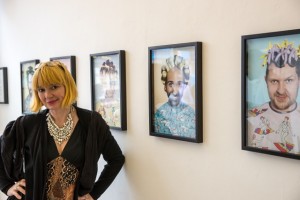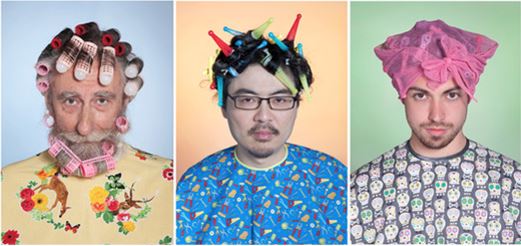A rather unconventional series by London-based artist Astrid Schulz will be exhibited in Saarbruecken (Germany) for a second time from April, 13 to May, 13 2016. Inspired by the content of the novel “The Daughters of Egalia” (by Norwegian writer Gerd Mjøen Brantenberg) the photographer questions social stereotypes and photographic clichés. For her project ‘Hairdressers’ Astrid swapped gender based positions – her protagnists are men at a hair saloon, wearing curlers on their heads and in their beards. ‘Hairdressers’ have been selected to highlight the opening event at the German Hairstylists convention in Saarbrücken at Handwerkskammer des Saarlandes (Trade Cooperation of Saarland).
The bemusing portraits look stunning on Hahnemühle FineArt Baryta paper; they are printed in wonderful shades of pastel and candy colours. The charming yet witty expressions of the male models are fascinating and the deliberate use of pelerines with contrasting pattern ad a satirical meaning and invite every observer to linger and chuckle.
Astrid’s 12 images have been created in co-operation with make-up artist Konnie Daniel in London. ‘Hairdressers’ is on display at ‘Sali E Tabbachi’ in Saarbruecken from 8 May to 2 June in 2015.
When did you discover your passion for photography?
As a teenager – I was 15 at the time when I felt the desire to be a photographer. At the age of 16 I had saved enough money to buy my first camera … a Minolta, loaded with b/w films.
Which was the project you succeeded in entering the art market?
With ‘Food keeps Body & Soul together’, a portrait series with protagonists ‘wearing’ their favourite food.
Which photographic subject is particularly appealing to you?
Portraits! I love working with people – whether in a controlled studio environment like in the ‘Hairdresser’ series or on location for photographic documentations, which are published in international photo books.
Who inspires you most?
Many of my favourite photographers lean towards documentary photography (eg Nadav Kander, Sebastiano Salgado, Guy Tillim). During the time of my studies I was influenced by David Steward, a British advertising photographer. I liked his humorous style and his use of pop art colours. However, my images have many quotations from my second profession: I have been working as a costume designer for film & TV, which reflects particularly in my personal work.
How would you describe your photographic style?
Colourful and bold – with a dash of humour.
In your opinion, what makes a good photographer?
For me a good photographer starts with a good idea or concept and follows it through with discipline and dedication. I don’t even mind about the technical know-how, as long as the result is compelling and tells a story. Of cause, having technical knowledge helps! 🙂
What importance do you place on the printed presentation of your artwork?
Today, for many people the digital image is the first and only representation of their photographic work. It has just been 10 years ago when images were printed and used in photo albums. Of cause – I know how important it is to be able to find my images on the Internet, but a printed image has a completely different significance. I must admit, I am still a bit ‘old-fashioned’: I prefer things that you can actually touch and that have the ability to enchant an audience due to its physical size – in other words at an exhibition wall or even in peoples homes.
Which is your favorite Hahnemühle paper?
For my documentary photography I like the matte fine art papers best; my preference is Photo Rag® Bright White, and Photo Rag® Ultra Smooth. For everything else I use the brilliant FineArt Baryta.
What is your next project that you would like to realize?
Oh, I have more than one project in mind. I’m still working on a portrait series about people who make food on a small scale, usually from home. This project started in Vietnam, then continued in Senegal and next year I will take it to Bolivia. About my next studio project I am still contemplating: either ‘The 7 Virtues’ or a series of fictional film posters.
Thank you. More photographs by Astrid Schulz including examples of her costume work for film & TV can be seen on her website: http://astridschulz.com/
On Facebook you can watch a short video about ‘the making of’ the prints by the exhibition’s curator and fellow photographer Jörg Karrenbauer.








